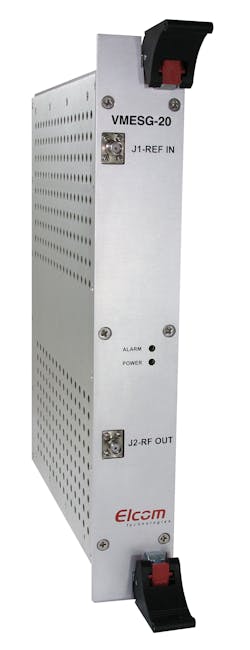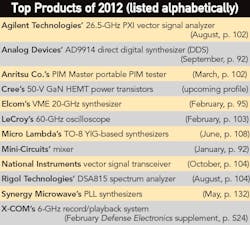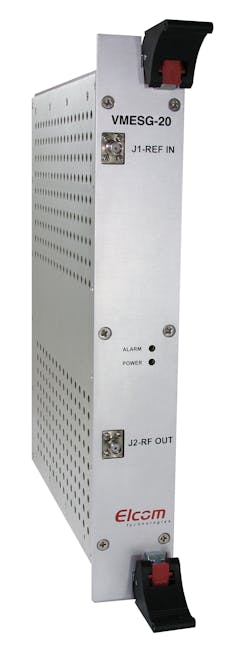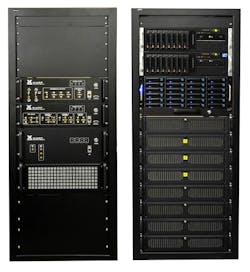Customer demand will generally drive new-product development. Meeting that demand with a cost-effective solution, however, often requires creativity and ingenuity. Each December, in our Top Products of the Year report, Microwaves & RF applauds a small sample of those outstanding products developed during the year in response to customers’ needs. These products have delivered new levels of performance, tackled new problems and, in general, provided great value for customers with shrinking wallets. They are listed in alphabetical order in the accompanying table. As readers should note, this is just a sampling of many other fine products developed during 2012 by an industry with more than its share of talented and innovative design engineers.
Frequency synthesizers are essential components in many high-frequency systems. Several were on the 2012 Top Products list, including a broadband unit from Elcom Technologies and smaller models from Synergy Microwave Corp. and Micro Lambda Wireless. The model VMESG frequency synthesizer from Elcom Technologies (Fig. 1) squeezes a full-performance 1-to-20-GHz frequency synthesizer onto a compact two-slot VME card. Designed for use with a 100-MHz external frequency reference—such as an oven-controlled crystal oscillator (OCXO) or a temperature-controlled crystal oscillator (TCXO)—it delivers the type of performance associated with a larger rack-mount synthesizer, with phase noise of -109 dBc/Hz offset 1 kHz from a 10-GHz carrier and -122 dBc/Hz offset 10 kHz from a 10-GHz carrier. The VMESG frequency synthesizer generates output levels of typically +23 dBm with typical harmonics of -35 dBc and spurious levels of -60 dBc. The standard tuning resolution is 10 kHz, with an option for resolution of 1 Hz. These synthesizers boast frequency switching speed of 10 μs for a full-band frequency step, and even faster when switching across less bandwidth.
1. Frequency synthesizer in the VMESG series provide excellent spectral purity in a compact VME card format, with models available for full coverage from 1 to 20 GHz. (Photo courtesy of Elcom Technologies.)
The MLSP-Series of frequency synthesizers from Micro Lambda Wireless are based on yttrium-iron-garnet (YIG) oscillator technology, making great strides in miniaturizing the technology for use in modular systems. These sources measure just 5 x 3 x 1 in., weigh only 15 oz. (426 g), and can fit into a two-slot PXI chassis. The synthesizer series includes models as wide as 2 to 18 GHz and 2 to 20 GHz with frequency switching speeds of 1 ms for a 100-MHz switch, and typically about 7 ms for a full-band change in frequency. The frequency resolution is 1 kHz, while harmonics are typically -12 dBc and spurious content is typically -60 dBc. For carriers from 2 to 8 GHz, the synthesizers achieve phase noise of typically -93 dBc/Hz offset 10 kHz from the carrier and typically -114 dBc/Hz offset 100 kHz the carrier. For carriers from 8 to 16 GHz, the phase noise is typically -85 dBc/Hz offset 10 kHz from the carrier and -107 dBc/Hz offset 100 kHz from the carrier. The frequency synthesizers, which provide +10-dBm minimum and as much as +13-dBm output power, run under five-wire SPI or Universal Serial Bus (USB) control.
The model KMTS2500-200800 frequency synthesizer from Synergy Microwave Corp. combines direct-digital-synthesis (DDS) and phase-lock-loop (PLL) technologies to generate stable, low-noise output signals. A low-noise PLL multiplies a reference frequency to the maximum frequency allowed by the DDS circuit. The DDS output signal is then filtered and provided as a reference to a secondary PLL that will multiply the frequency to the desired range. The modular synthesizer features typical phase noise of -97 dBc/Hz offset 10 kHz from the carrier for carriers from 2 to 8 GHz, with typical spurious noise of -50 dBc. The architecture can be combined with low-noise voltage-controlled oscillators (VCOs) to yield low-noise outputs at X- and Ka-band frequencies.
An even smaller, component-level frequency synthesizer, the model AD9914 DDS from Analog Devices, is capable of operating at clock frequencies to 3.5 GHz. With its on-board 12-b digital-to-analog converter (DAC), it can provide output signals to about 1.4 GHz with excellent spectral purity. The DDS device includes a 32-pin parallel port for flexibility of user control.
Another essential high-frequency component, the RF/microwave mixer, was given new life by Mini-Circuits when the company developed a line of hermetic mixers through 12 GHz with prices starting at only $5.95 each (Fig. 2). Based on reliable low-temperature-cofired-ceramic (LTCC) technology, Mini-Circuits’ MAC series mixers measure just 0.30 x 0.25 x 0.060 in. (7.62 x 6.35 x 1.52 mm) in their ceramic housings. Suitable for commercial, industrial, and military applications, these mixers feature broad frequency ranges, such as the model MAC-12G+ with radio-frequency (RF) and local-oscillator (LO) range of 3.8 to 12.0 GHz, and with versions available for LO power levels of +7, +10, and +13 dBm. The typical LO-to-RF isolation is 40 dB (minimum of 27 dB) while the typical LO-to-IF isolation is 24 dB (minimum of 17 dB).
2. This compact mixer is based on LTCC technology and a compact hermetic ceramic housing for applications through 12 GHz. (Photo courtesy of Mini-Circuits.)
Cree’s new 50-V GaN HEMT devices are available in 100- and 200-W models for use in frequency bands through 2.7 GHz. Supplied in flange-mount and surface-mount ceramic-metal housings, the transistors are internally impedance matched and deliver high gain with high efficiency, featuring solid-state power levels that legitimately challenge the performance levels of vacuum-tube devices, such as traveling-wave tubes (TWTs).
Measuring instruments, whether for the laboratory or in the field, are vital to the advancement of the industry—and thus, a mainstay on these annual Top Products lists. The LabMaster 10Zi digital sampling oscilloscopes (DSOs) from LeCroy Corp., for example, leverage silicon-germanium (SiGe) device technology to reach new levels of measurement capability (Fig. 3). These active devices, with cutoff frequencies to 200 GHz, are used in analog-to-digital converters (ADCs) within the oscilloscopes. The modular instruments, built with combinations of acquisition and control modules, can provide as many as 10 measurement channels, each with 60-GHz bandwidth or 20 measurement channels, each with 36-GHz bandwidth. For the 36-GHz bandwidths, the single-shot sampling rates reach 80 Gsamples/s while for the 60-GHz bandwidths, the single-shot sampling rates extend as high as 160 Gsamples/s. The DSOs feature 15.3-in. display screens with 2560 x 1600 pixel resolution and can show captures signals on horizontal scales ranging from 10 ps/div to 64 s/div.
3. This line of DSOs employs SiGe active device technology to achieve channel bandwidths as wide as 60 GHz for 10 measurement channels. (Photo courtesy of LeCroy Corp.)
Modular instruments are increasingly finding their way onto test benches, not only for their flexibility but for their outstanding performance [including in PXI and PXI Express (PXIe) modular formats]. For example, a PXI-based vector-signal-analyzer (VSA) from Agilent Technologies includes all the modules needed to perform signal analysis on 4 x 4 multiple-input, multiple-output (MIMO) communications systems and devices from 10 MHz to 26.5 GHz. It provides analysis bandwidths as wide as 780 MHz with a number of different PXI and PXIe modules. The VSA system includes a model M9362A PXIe frequency downconverter module with frequency range of 10 MHz to 26.5 GHz, which can simultaneously frequency translate four channels with instantaneous bandwidths as wide as 1.5 GHz. Additional modules are the model M9302A local oscillator module, a two-slot, 3U PXI module capable of +16 dBm output power from 3 to 10 GHz and a model M9168C programmable PXI step attenuator with attenuation range of 0 to 101 dB in 1-dB steps from DC to 26.5 GHz and attenuation accuracy of ±0.4 dB at 26.5 GHz.
Once signals have been downconverted to an intermediate-frequency (IF) range, the single-slot model M9352A four-channel PXI hybrid IF amplifier/attenuator offers 0 to 31.5 dB attenuation in 0.5-dB steps and as much as 31.5-dB small-signal gain in 0.5-dB steps from 1 MHz to 1 GHz. It has a noise figure of 3 dB and third-order intercept point of +43 dBm. Signals are converted into the digital realm by means of a model M9202A single-slot 3U 12-b PXIe digitizer module with 1-GHz bandwidth, 30-MHz nominal instantaneous bandwidth, and sampling rates to 2 Gsamples/s. The modules are mounted in a PXI/PXIe chassis and operated under the command of a controller module.
The DSA815 spectrum analyzer from Rigol Technologies makes basic measurement power from 9 kHz to 1.5 GHz affordable for almost everyone, with a starting price of $1295. The versatile spectrum analyzer provides resolution-bandwidth filters from 100 Hz to 1 MHz and video-bandwidth filters from 1 Hz to 3 MHz. It operates with an internal 10-MHz frequency reference oscillator and allows the reference level can be set from -100 to +20 dBm in 1-dB steps to show a wide range of signal levels. With an optional preamplifier, the displayed average noise level (DANL) of typically -130 dBm from 100 kHz to 1 MHz and -135 dBm from 1 MHz to 1.5 GHz. Without the preamplifier, the DANL is a still-respectable -110 dBm from 100 kHz to 1 MHz, and -115 dBm from 1 MHz to 1.5 GHz.
For measurements in the field, the Passive Intermodulation (PIM) Masters series from Anritsu Co. can generate the test tones needed within specific wireless communications bands for on-site PIM testing of components and systems—including in frequency ranges of 869 to 894 MHz and 1930 to 1990 MHz. The PIM Masters, which can generate test tones at levels to about 40 W, measure only 12 x 17 x 20 in. (300 x 425 x 500 mm) and weigh about 59 lbs (27 kg) for ease of transport to cellular or other wireless communications towers and stations.
For military and other signal-intelligence (SIGINT) applications, the Wideband Acquisition Record and Playback (WARP™) system from X-COM Systems can instantly capture the entire signal spectrum from DC to 6 GHz even over long periods of time, when equipped with adequate memory (Fig. 4). The system allows digital storage of signal bandwidth, for close scrutiny at any time. The hardware is supported by the firm’s Spectro-X software, which allows an operator to search for waveforms of interest. The software includes numerous search algorithms for finding arbitrary as well as standards-based wireless signals. The WARP system is available with instantaneous capture bandwidths of 1.5, 3.0, and 6.0 GHz.
4. This system can capture and playback instantaneous bandwidths of 1.5, 3.0, or 6.0 GHz across a frequency range of DC to 6 GHz for military, surveillance, and SIGINT applications. (Photo courtesy of X-COM Systems.)
In some cases, new types of instruments were needed to keep pace with emerging wireless test needs. Model PXIe-5644R is a vector signal transceiver (VST) from National Instruments that combines a vector signal generator (VSG) and VSA with a field-programmable gate array (FPGA), forming a new kind of instrument for wireless communications testing. It tunes from 65 MHz to 6 GHz with instantaneous bandwidth as wide as 80 MHz and 1-Hz tuning resolution. The entire unit fits in a single three-slot PXIe module, and the inclusion of the FPGA makes it possible to program the VST for evaluating the operation of modern wireless systems with the most complex digital modulation formats.
About the Author
Jack Browne
Technical Contributor
Jack Browne, Technical Contributor, has worked in technical publishing for over 30 years. He managed the content and production of three technical journals while at the American Institute of Physics, including Medical Physics and the Journal of Vacuum Science & Technology. He has been a Publisher and Editor for Penton Media, started the firm’s Wireless Symposium & Exhibition trade show in 1993, and currently serves as Technical Contributor for that company's Microwaves & RF magazine. Browne, who holds a BS in Mathematics from City College of New York and BA degrees in English and Philosophy from Fordham University, is a member of the IEEE.





